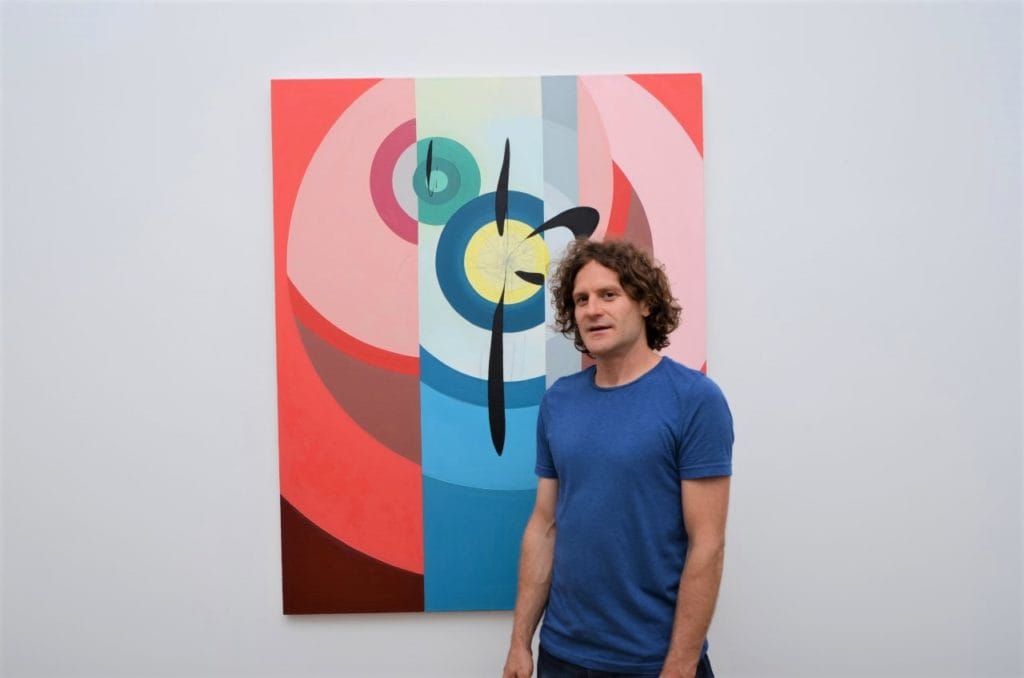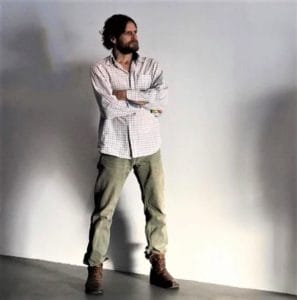Curating for the Isolated: Virtual Exhibit Showcases Work Made in Quarantine

Artists create under myriad circumstances—in a studio, in group settings, or among peers, and each context inspires them in different ways. Now mandatory quarantines have become an unexpected stroke of inspiration for an artist like Seann Brackin.
“Our world perspective has changed,” said Brackin (MFA, ’07) in a video interview from his apartment in Madrid.
Streets there are virtually empty, he said. He even showed his interviewer a view of the streets, where only a few pedestrians strolled; then a cyclist transporting groceries came into the frame. The eerie stillness of the apartment buildings behind him is broken every evening when these buildings briefly come to life.
“Every night at 8:00 pm,” he said, “people go out on their balconies to clap for our healthcare workers.”
An artist who’s had showings in Spain since 2008 and in other countries across the globe, Brackin likewise partakes in the balcony-salute now that he’s had to shelter in place.
“I had a few planned showings for this spring and summer, which were canceled,” he said.
Creating ‘Art Made in Quarantine’
In the time since, Brackin, a graduate of Pacific Northwest College of Art who has a background in ceramics and 3-D design, was forced to get creative to best respond to the limitations caused by the COVID-19 pandemic. He was helped by a friend’s post about singer-songwriter Miranda July.
“He posted about the work she did in getting online submissions for a collaborative art project,” he explained. The project, Learning to Love You More, was a website active from 2002 to 2009 that served as a series of exhibitions open to everyone. Participants from around the globe were called to submit their work in response to “assignments” given by July and artist Harrell Fletcher.
In the site’s active years, over 8,000 participated worldwide. It has since been acquired by the San Francisco Museum of Modern Art as a preserved archival piece representing the modern age of media.
“It was the first website to be sold as a piece of art,” Brackin said.
Inspired by the premise, Brackin decided to curate his own project that has come to be known as Art Made in Quarantine.

“The objective was simple: Make an online international art show,” he said. “I gave participants a deadline, with the only rules being that the pieces were original, submitted by email, and that they had to be made while quarantining.” The call for submissions was translated by friends into French, Italian, Spanish, Korean, and Japanese, making the submissions diverse while allowing for word-of-mouth to spread quickly.
“I got submissions from nearly every continent,” he said. Out of 115 submissions, 17 countries are represented.
After receiving the wave of submissions, Brackin gave himself over two weeks to get the website up and running, learning to build it along the way.
“I did the coding myself. I wanted to model it after the Prado Museum, which is just down the block from me,” he explained. “I thought it could be different than a lot of the virtual tours from other museums, which in most cases were merely linking to their websites. I wanted this to serve as an actual exhibition.”
All submissions made in quarantine were posted.
In sharing these varied experiences with the world, Brackin hopes to show a communal vision of a shifting, everyday life.
“My intention in creating this exhibition is to gather and share perspectives in order to facilitate unity and healing as we mourn the lives that are being lost, process the change, and move on to the new world waiting for us,” he writes in the exhibit’s foreword.
Though the virtual exhibition is a first for Brackin, he has been offered many showings of his physical artworks over the last decade.
“My thesis at CGU actually gave me the opportunity to get my work out there,” he said of his Time Space-Travel Device for the Unification of Humanity project, which was shown at White Flag Projects of St. Louis and later purchased by Astral Valley Art Park.
A Humbling Experience
Brackin has enjoyed curating Art Made in Quarantine.
“I am humbled by the power and multitude of perspectives, thoughts, and emotions carried in this art,” he said. “I am truly honored by the trust these artists have shown in sending their work.”
Artistic expression while under quarantine has its limitations, but it serves a valuable purpose.
“It’s important to note that this is an imperfect solution, but it is a seed to get us where we need to go,” Brackin said. “We’re fortunate that technology has made it so much more accessible in a time like this.”
As he talked about the exhibit, Brackin was suddenly interrupted. A wave of sound came through the computer screen. It was 8 p.m. in Madrid.
“You can hear everyone clapping now,” he said.
***
- To view the exhibition Art Made in Quarantine, visit here.
- Visit here to learn more about CGU’s acclaimed MFA program.